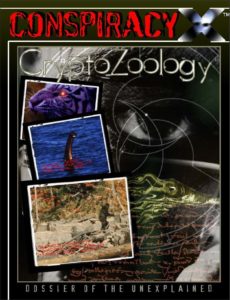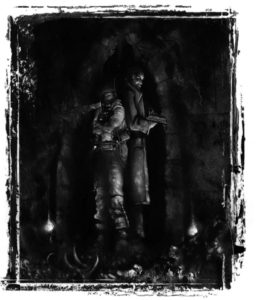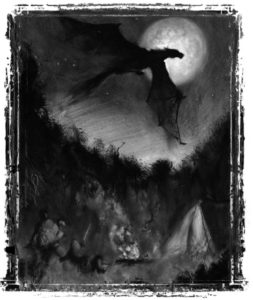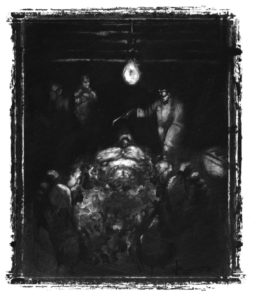 So, I’ll be honest, I’m not a big fan of mixing my cryptids with my aliens. Sure, the X-Files did it with their ‘Monster of the Week’ style offerings, but I like my extraterrestrials and Jersey Devils to stay in their own sandpits, thank you very much! It was therefore with some trepidation that I unsealed my (long unopened) copy of CryptoZoology: Dossier of the Unexplained for Conspiracy X First Edition.
So, I’ll be honest, I’m not a big fan of mixing my cryptids with my aliens. Sure, the X-Files did it with their ‘Monster of the Week’ style offerings, but I like my extraterrestrials and Jersey Devils to stay in their own sandpits, thank you very much! It was therefore with some trepidation that I unsealed my (long unopened) copy of CryptoZoology: Dossier of the Unexplained for Conspiracy X First Edition.
A Note – This review is written with the assumption that the reader is familiar with the setting and themes of the Conspiracy X RPG (or Con X as it is often abbreviated). For those of you who don’t, the one sentence summary would be – in Con X the players take on the roles of agents within a clandestine organization (known as Aegis) and are tasked with hiding the truth of aliens – and the like – from humanity.
The Physical Book
Published in 1997 by Eden Studios, CryptoZoology was released at the height of Con X’s first edition production run. Written by the usual suspects responsible for the development of this cool little game during that period – Richard Dakan, Jack Emmert, Alex Jurkat and Bernard Trombley – it exhibits all the hallmarks of a book that knows its audience. The immediate impression is that CryptoZoology was created with a lot of forethought, with an excellent structure and narrative design. The writing quality is top notch throughout, even though the variety of changes (both in content type and presentation styles) that is needed to achieve a book that is partly inspiration focused and partly rules driven (more on this later in the review). I’d also like to point out that a number of today’s game publishers could learn a lot from its quality editing – with few, if any typos or errors – and a consistency of language that makes the fantastical subject matter both ‘believable’ and yet readable.
Physically, CryptoZoology is a soft-covered, glue-bound sourcebook similar to so many RPG products released during the 90s. The art adorning the cover of the book is nothing to write home about; consisting of a generic background with a few familiar photos of well-known cryptids (Bigfoot, the Loch Ness Monster, etc.). It is, however, serviceable and comes complete with the black border, and distinctive logo that matches the esthetics of the rest of the Conspiracy X First Edition line. Coming in at 128 pages, its interior design is black and white with a good coverage of art (which, I have to say, is of a varying quality) and plenty of white space. I do want to take time out here and mention the formatting choices made around the text and content. As Eden Studios would go on to demonstrate in their later books and game lines – the design team have used the excellent approach of utilising different fonts and formatting to characterise the different types of information being presented within the book (i.e. ‘reports’ are presented with a typewriter like font, game setting material with a more mechanical typeface, etc.). This may seem a little off-putting when initially browsing the book, but the utilization of this structure really helps in keeping with the theme of the book (as a ‘grab bag’ of cryptids) and when reading its more interpretive content.
The Seekers
 The first real content of the supplement (after the book’s introduction, summary and timeline) appears in Chapter 2 – The Seekers. This introduces of two ‘new’ organisations which have a specific interested in the cryptid phenomena and the wider Unexplained. The first of these – The Royal Cryptozoological Society (RCS) – is made out to be an innocent group of scientists and explorers attempting to discover the truth behind the rumors of cryptozoological encounters and the unknown. And you never know, this may well be the case, but behind their benevolent public face, the RCS hides a variety of secrets that not even the most prominent of its members seem privy too. For example, just who makes up their governing board and just where does all that funding get funneled too? Not only that, but this group is an obvious safe haven of those fanatical types – individuals unwilling to believe science over rumour or hearsay!
The first real content of the supplement (after the book’s introduction, summary and timeline) appears in Chapter 2 – The Seekers. This introduces of two ‘new’ organisations which have a specific interested in the cryptid phenomena and the wider Unexplained. The first of these – The Royal Cryptozoological Society (RCS) – is made out to be an innocent group of scientists and explorers attempting to discover the truth behind the rumors of cryptozoological encounters and the unknown. And you never know, this may well be the case, but behind their benevolent public face, the RCS hides a variety of secrets that not even the most prominent of its members seem privy too. For example, just who makes up their governing board and just where does all that funding get funneled too? Not only that, but this group is an obvious safe haven of those fanatical types – individuals unwilling to believe science over rumour or hearsay!
But from a threat perspective, the other Seekers detailed here – The Titanidae – could provide even more of a concern for a conspiracy like Aegis than the RCS. A collection of psychics and mystics, the Titanidae are set on not just understanding the unknown, but also controlling it. Another powerful sect they, like the RCS, are ripe for infiltration or influence from all three alien menaces facing humanity and could quickly become key antagonists opposing Aegis cause. I don’t want to say too much about this group, but I think they are one of the highlights of the book, and their motivations and goals could be easily ported to other conspiracy/horror RPGs if required.
Like all good mysteries there is enough information provided in both organisation’s descriptions to spark numerous scenario ideas and adventures from a Game Master. More importantly, all this evidence is provided in a manner as to never explicitly call out what either group is truly after. This adds another layer conspiracy to both parties, as what may be fact in one encounter with them could very well be different the next time they are confronted.
I think it’s important, also, to make mention of the player-characters options available to anyone wanting to create an agent aligned to either society. Backgrounds like a RCS Academic Outcast or Titanidae Mole would make for a fascinating agents and really enhance the experience around the game table – with the players now just as suspicious of each other as they are of everything else they encounter in their missions!
The Sightings
 The second main section of the book is titled – The Sightings – and details a number of the most common cryptids found around North America and the world. Here we find the old favourites from Chupacabras to the Yeti, Nessie to the Mothman. But where you might expect to find some sort of detailed cryptozoological monster manual, you instead get only a glimpse of what the creatures might be usually through some sort of ‘official’ report or first-person descriptive encounter. These reports, statements or summaries are written in the voice of the likes of the RCS, Titanadae or even Aegis itself. This approach provides a narrative and mystery to what are otherwise familiar and ‘common day’ monsters, many of which have been debunked in the real world. I could see these documents being used as handouts for the characters when investigating related events, or more interestingly as red herrings to their investigations!
The second main section of the book is titled – The Sightings – and details a number of the most common cryptids found around North America and the world. Here we find the old favourites from Chupacabras to the Yeti, Nessie to the Mothman. But where you might expect to find some sort of detailed cryptozoological monster manual, you instead get only a glimpse of what the creatures might be usually through some sort of ‘official’ report or first-person descriptive encounter. These reports, statements or summaries are written in the voice of the likes of the RCS, Titanadae or even Aegis itself. This approach provides a narrative and mystery to what are otherwise familiar and ‘common day’ monsters, many of which have been debunked in the real world. I could see these documents being used as handouts for the characters when investigating related events, or more interestingly as red herrings to their investigations!
Genus & Species
The first sentence of this section describes best its purpose in the supplement – “So, what do I do with all this stuff?”. Here we get to learn the truth behind each of the cryptids presented in the Sightings section… or perhaps I should say ‘truths’!
In an approach that has become much more prevalent today, the authors of CryptoZoology have provided a variety of options to what each of the detailed Cryptids could be, with each possibility getting its own write up, statistics and sampling of further mysteries. For example, is Bigfoot simply a brutish throwback ancestor of man, or are they a noble ancient race unchanged since the age of the Atlanteans? Such possibilities provide enough firm ground for a Game Master to build a compelling story with what they are presented, but also does not lock these cryptids into a single purpose or function. (I’d like to imagine a campaign where Bigfoot creatures are encountered a number of times and each meeting has a different origin/source.) It almost goes without saying, that there’s enough information and ideas in this chapter to spark dozens of missions and scenarios (with plenty of them tying back into the core alien conspiracies facing the characters).
Wrap-up and Summary
 The book wraps up with an appendix providing both a summary of the powers and abilities presented in the book, as well as a short list of mundane animals (i.e. bears, crocodiles and the like). I quite like the idea of collecting everything in one place, especially as it doesn’t take up too many pages.
The book wraps up with an appendix providing both a summary of the powers and abilities presented in the book, as well as a short list of mundane animals (i.e. bears, crocodiles and the like). I quite like the idea of collecting everything in one place, especially as it doesn’t take up too many pages.
So, what does one say about CryptoZoology: Dossier of the Unexplained? First, it’s not what I expected, when I first thought about reviewing this book. I had thought we were going to get an outdated list of monsters and cryptids that would be roughly shoehorned into the game’s UFO mythology. Instead we get a ‘grab bag’ of ideas, creatures and conspiracies that provides a smorgasbord of options and opportunities, that even the most time-poor Game Master could run with little effort. Sure, it’s a slight shame that no novel or original cryptids are provided, but there are enough new takes on the old classics to still make it worth the reader’s while.
Does one go out and track down a copy of this 23-year-old RPG supplement? My answer would be yes, especially if you are into conspiracy roleplaying or cryptozoology in general. It is packed with ideas and examples, and for only a few bucks (in electronic format) it’s a great read! Of course, if you’re a Conspiracy X fan like myself the question has to be… why don’t you own it already?


Leave a Reply